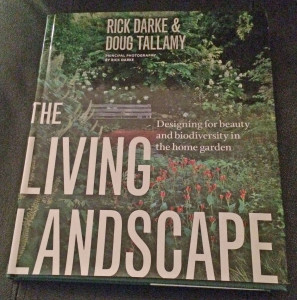
The Living Landscape: Designing for beauty and biodiversity in the home garden, by Rick Darke and Doug Tallamy, is a book well worth reading. Blending Rick’s perspective as a plant ecologist/horticulturist/landscape designer and Doug’s as an entomologist/behavioral ecologist/ornithologist has resulted in a book focused on how native plants can play essential as well as functional roles in gardens designed for multiple purposes.
I was impressed with the emphasis on durability, i.e. the capacity to thrive over a long period of time without being highly dependent on “resource-consuming maintenance” which I interpret as irrigation, and with the recognition that natives are not always better adapted than exotics. The best landscapes are a combination of both. The authors offer this book as a means by which we can create landscapes that support life without sacrificing aesthetics. I’ve long believed that no matter how functional landscapes may be, e.g. rain gardens, if they are not beautiful, they will not be adopted.
Unfortunately, the typical urban/suburban landscape is boring and lacks many of the living layers that characterize functional ecosystems but because that is what we are used to seeing, it has become acceptable. This thoughtful book is an effort to change that norm and attempts to educate us on reintroducing the needed layers to residential landscapes. Without all the layers that provide food and shelter, we lose many of the birds and insects that are endemic to them.
Chapter One looks at wild systems with the woodland as a prime example and delineates the layers, both vertical and horizontal, that compose it. However it also includes a section on wetlands because many properties have an area that doesn’t drain well. In the past, and even today, the usual solution is installing a drainage system instead of selecting plants that thrive in this habitat. The discussion of layers also touches on temporal layers (time and opportunity) and cultural layers, i.e. the effects that “civilization” has imposed on the land, and the ensuing vegetational patterns.
Chapter Two looks at the way plants and wildlife interact in a regional ecosystem. I knew a bit about the importance of these specialized interrelationships but was overwhelmed by the detailed examples put forth.
Chapter Three asks and answers the question, “What does your garden do for you and for the environment?” Gardens can protect our watersheds and biodiversity, improve air and soil quality, moderate extreme weather, and sequester carbon. I learned that the amount of rainfall is directly tied to the number of plants in a given area. Do you love birdsong? If so, you need to plant trees that support their needs. Do you love plants? If so, you need to provide nesting sites for pollinators which service them.
Chapter Four provides examples and strategies for developing one’s ability to see the local biological diversity that we often overlook while Chapter Five applies these concepts and strategies to the home garden. The authors would posit that most gardens have been an attempt to beautify our environment without thought to designing layered, biologically diverse, and functional landscapes. Being practical is not incompatible with these goals or with creating spaces that give us pleasure. I really like their
use of the term organic architecture. Instead of inserting hard surface walls and surfaces into our landscape, it suggests that we delineate spaces with vegetation instead. It is less costly and has less impact on the environment.
The last part of the book is a series of charts by region that specify, by the use of symbols, which landscape and ecological functions are filled by the plants mentioned in the book.
Read this book slowly so that you can absorb all of its philosophical and ecological threads. Although this is a highly educational, thoughtful and thought-provoking book, it is also a delight to the eyes because the photographs, most by Rick Darke, are works of art. They made me want to walk very slowly in the natural landscape so as not to miss any of its multitudinous details. You probably know by now that I am in love with this book.
Darke, Rick and Tallamy, Doug, The Living Landscape: Designing for beauty and biodiversity in the home garden, Timber Press, Portland, 2014, $39.95.


1 Comment